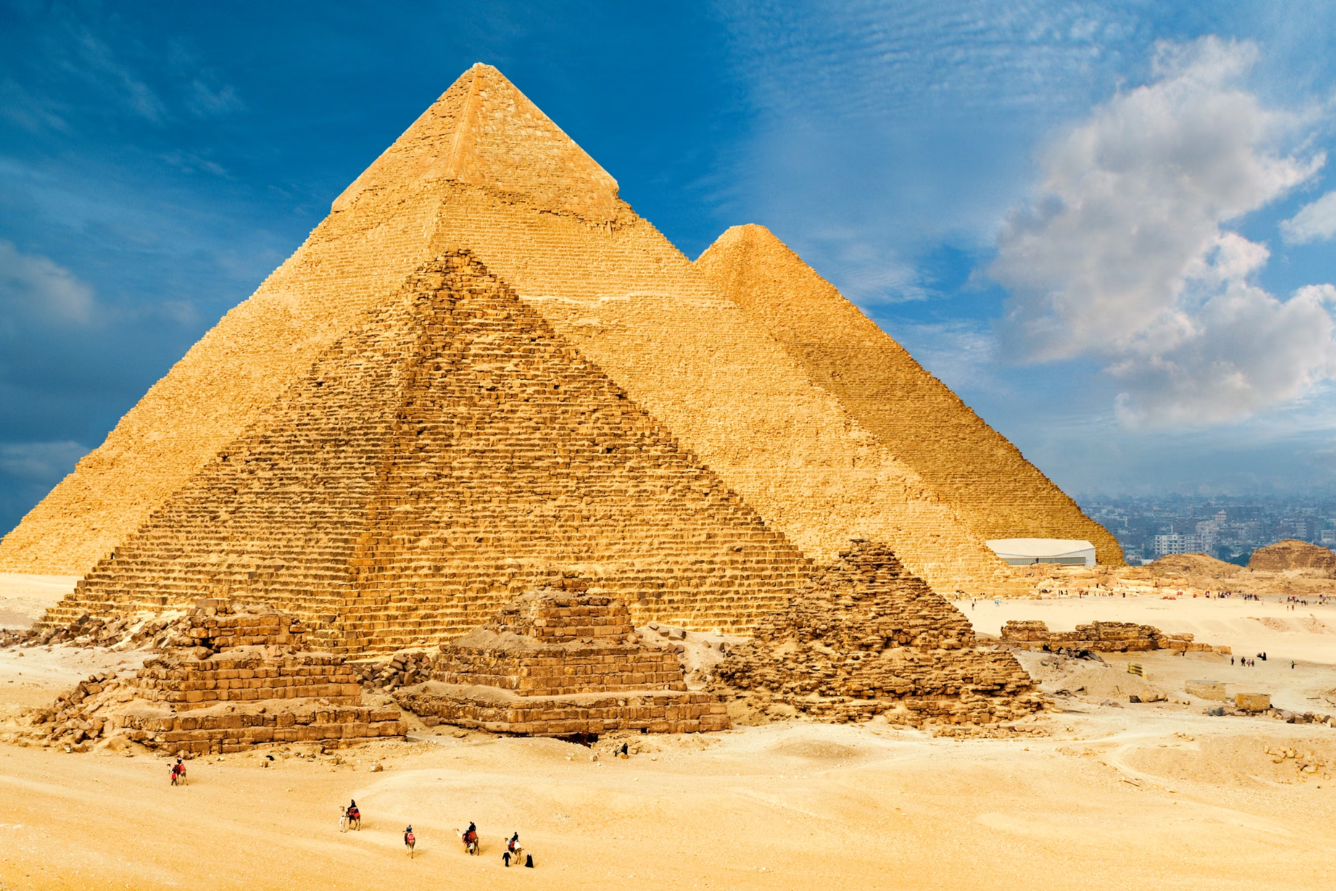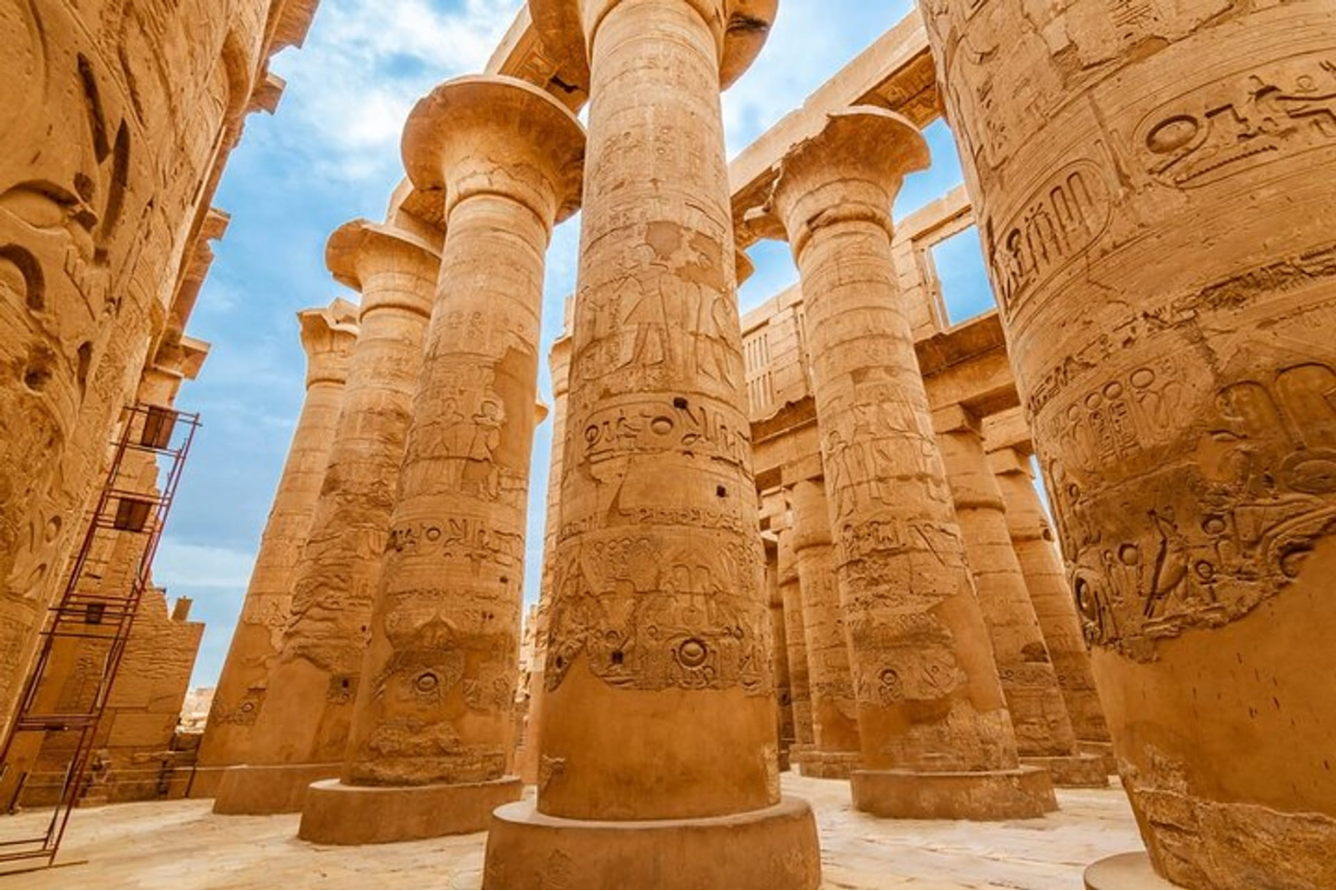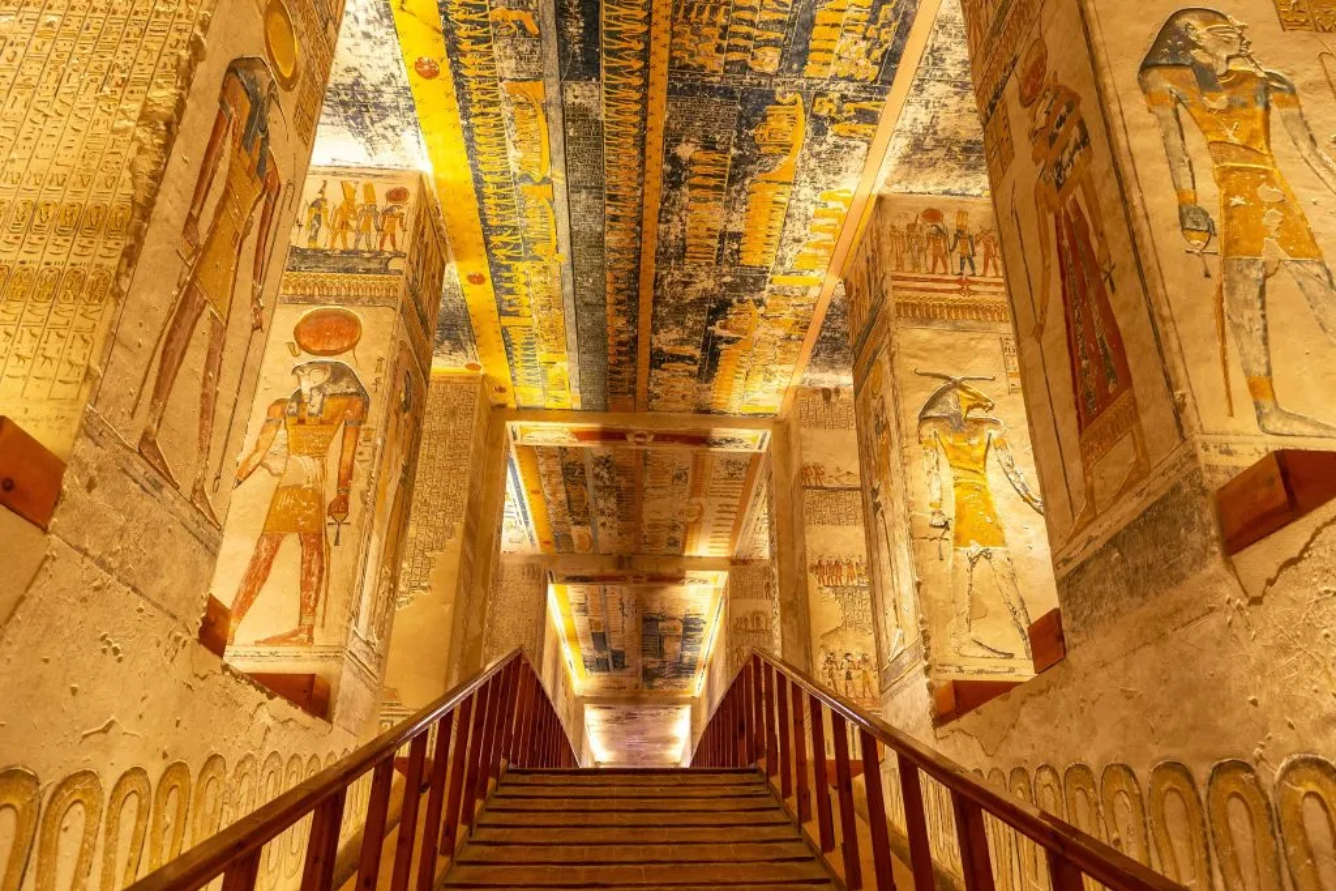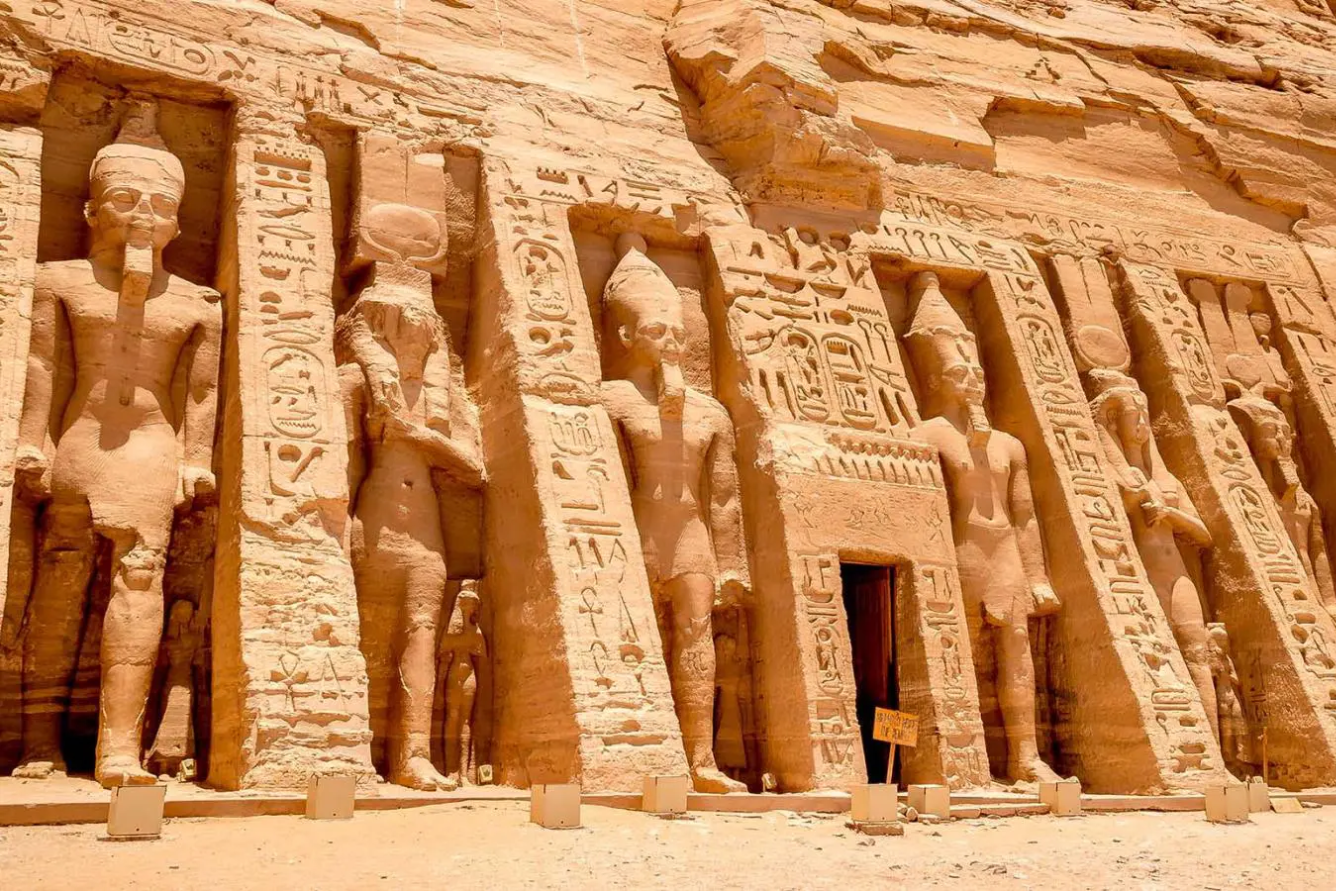1. The Great Pyramid of Giza
The Giza Pyramids stand tall as gatekeepers to time (Photo source: Collected)
No tour of Egypt’s wonders can begin without a visit to the Pyramids of Giza. Under the scorching desert sun, three massive monoliths stand like gatekeepers to time, silently watching humanity pass through thousands of years of history.
The Pyramid of Cheops, also known as the Great Pyramid, was once considered the only remaining wonder of the seven wonders of the ancient world. With an original height of nearly 147 meters, more than two million blocks of stone stacked on top of each other according to a perfect calculation that modern science still disputes, this structure has become an unsolved mystery. Each block of stone seems to whisper the story of the powerful Pharaohs, about beliefs in the afterlife and the desire for immortality.
Next to Kheops are the Pyramids of Khefren and Menkaure – smaller but no less impressive. Together with the mysterious Sphinx, the Giza monument complex is like a majestic melody of ancient Egyptian civilization, making anyone who has seen it once feel amazed and admired.
2. Karnak Temple
Karnak Temple is always ranked among the most sacred and massive heritages (Photo source: Collected)
When it comes to the wonders of Egypt, Karnak Temple is always ranked among the most sacred and massive heritages. Located in the city of Luxor, which was once the glorious capital of the ancient Egyptian empire, the Karnak Temple complex is the crystallization of thousands of years of history, with giant stone columns reaching up to the sky like eternal stone trees.
With more than 134 pillars in the Hypostyle Hall, Karnak Temple brings an overwhelming feeling, like being lost in a sacred stone forest, where sunlight shines down through the gaps, creating a magical dance of light. The elaborately carved reliefs on each cliff tell stories of gods, heroic victories and sacred rituals. Standing in the middle of that space, visitors will clearly feel the ancient spirit, as if whispers from the past are echoing, awakening the memories of a once glorious empire.
3. Valley of the Kings
Inside a tomb in the Valley of the Kings (Photo source: Collected)
Hidden in the rugged sandstone slopes west of Luxor, the Valley of the Kings is the resting place of some of Egypt’s most famous pharaohs. Amidst the harshness of nature, it is one of Egypt’s most serene and sacred wonders.
Unlike the massive exteriors of the pyramids, the tombs in this valley were built deep underground. The interiors were decorated with colorful murals depicting the king's soul's journey through the underworld , towards eternal immortality.
The tomb of Tutankhamun – the youngest Pharaoh in history – was discovered almost intact, shocking the world in 1922. The glittering treasures and the famous golden mask are proof of the belief in life after death, and also proof of the magnificence of the wonders of Egypt.
4. Abu Simbel Temple
Abu Simbel Temple is perhaps the most impressive work in terms of engineering and vision of ancient people (Photo source: Collected)
Of all the wonders of Egypt, the Abu Simbel Temple is perhaps the most impressive example of ancient engineering and vision. Carved directly into the cliffs on the shores of Lake Nasser, it is famous not only for its engineering feat but also for its monumental relocation in the 1960s to save it from being submerged.
The main temple is dedicated to Amun and Ra, but also to Pharaoh Ramesses II – one of the greatest kings in Egyptian history. Four colossal statues, up to 20 meters high, in front of the main temple are the embodiment of the king's inviolable authority. When the dawn light shines directly into the main hall every February 21 and October 21, illuminating the three statues inside, it is not only an astronomical phenomenon but also a testament to the superior mathematical and astronomical intelligence. The miraculous existence and resurrection of the Abu Simbel temple is a reminder that the wonders of Egypt never belong to the past. They live forever.
5. Temple of Queen Hatshepsut
The Temple of Queen Hatshepsut is a testament to the wisdom, ingenuity and strength of women (Photo source: Collected)
The wonders of Egypt are not only associated with male kings, but also with powerful women like Queen Hatshepsut. Her temple at Deir el-Bahari is a testament to the wisdom, ingenuity and strength of a woman who once claimed to be a king in an ancient, male-dominated society.
Built right under the vertical cliffs of Mount Thebes, the Hatshepsut Temple seems to melt into the surrounding natural landscape. Three airy terraces, straight columns, and delicate symmetrical architecture have turned this place into a perfect work of art. With each step, visitors are led on a historical journey of a queen who brought Egypt to a period of peace and prosperity.
Egypt is not just a land of sand and desert, but a treasure trove of heritages that touch the soul of humanity. The wonders of Egypt are not just majestic piles of rocks, but echoes of time, mirrors reflecting human wisdom, faith and aspiration to reach immortality. Every step on this land is a step into the past, a silent dialogue between the present and the ancient. And it is in this journey of discovery that we not only find the beauty of a civilization, but also find a part of ourselves - the desire to live, love and leave an immortal mark in the flow of time.
Source: https://www.vietravel.com/vn/am-thuc-kham-pha/ky-quan-o-ai-cap-v17348.aspx











![[Photo] Cat Ba - Green island paradise](/_next/image?url=https%3A%2F%2Fvphoto.vietnam.vn%2Fthumb%2F1200x675%2Fvietnam%2Fresource%2FIMAGE%2F2025%2F12%2F04%2F1764821844074_ndo_br_1-dcbthienduongxanh638-jpg.webp&w=3840&q=75)


























































![[VIMC 40 days of lightning speed] Da Nang Port: Unity - Lightning speed - Breakthrough to the finish line](https://vphoto.vietnam.vn/thumb/402x226/vietnam/resource/IMAGE/2025/12/04/1764833540882_cdn_4-12-25.jpeg)
















































Comment (0)